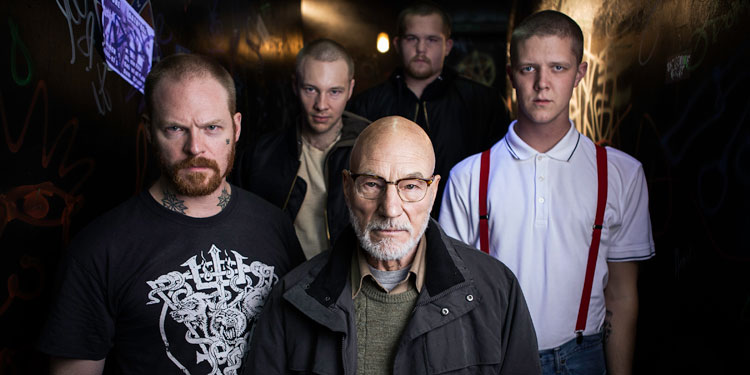 There is perhaps no genre in cinema for which music has been more important than horror. It’s a trend that continues with Green Room, the new movie from Blue Ruin director Jeremy Saulnier, which mixes together punk, neo-Nazis and edge of your seat thrills to create an acclaimed horror flick with music at its core.
There is perhaps no genre in cinema for which music has been more important than horror. It’s a trend that continues with Green Room, the new movie from Blue Ruin director Jeremy Saulnier, which mixes together punk, neo-Nazis and edge of your seat thrills to create an acclaimed horror flick with music at its core.
Even before there were talking pictures, the fledgling horror genre knew the importance of music to impart of sense of tension. FW Murnau’s famed 1922 vampire movie Nosferatu was originally accompanied by a full score, by Hans Erdmann, written to be played by an orchestra while the movie played. The music is reported to have heightened the experience immensely, but sadly it’s since been lost.
Almost from the moment synchronised sound came to cinema, filmmakers realised that music was their friend. In Fritz Lang’s creepy 1931 movie, M, about a child killer stalking the streets of a German town, the presence of the murderer is signified by him whistling Edvard Grieg’s In the Hall of the Mountain King. It’s still eerie 85 years later, and it came only a few years after the possibility of actually using music inside a movie was possible.
Ever since then horror and music have been intertwined, from the Universal monster movies of the 1930s, through the Hammer movies of the 60s and 70s (where the music was largely the work of James Bernard). In fact, while Universal’s first couple of 30s horror movies had virtually no music, they quickly realised the power it could bring to the genre, to the extent that Franz Waxman’s work on 1935’s The Bride Of Frankenstein is considered by many to be the first ever modern movie score, and one of the most influential ever written. It also helped introduce the concept of using low pulsing notes in horror movies to help induce tension.
It is not a coincidence either that two of the most recognisable pieces of film music ever written were for horror films – Bernard Herrmann’s slashing strings for 1960’s Psycho, and John Williams’ brooding Jaws theme.
The perfect marriage of music and horror movie can turn something into a phenomenon. Mike Oldfield’s 1973 instrumental album Tubular Bells might well have been destined for complete obscurity if it hadn’t been used in the opening sequence of The Exorcist, helping to set the tone for what at the time was one of the highest grossing movies ever made. As a result the album became a massive bestseller and helped launch Richard Branson’s Virgin Music (and therefore the entire Virgin empire). It remains one of the top 50 selling albums ever in the UK.
There are also directors and subgenres of horror so tied up with particular styles of music it’s almost impossible to think of one without the other. For example, the 1970s work of Italian horror maestro Dario Argento, such as Suspiria, Tenebre and Inferno, is intrinsically tied to the prog rockers he chose to bring their own strange sounds to his projects. Indeed, in the 70s horror and prog rock were unexpectedly tied together, including The Exorcist’s use of Tubular Bells and director John Carpenter’s self-penned synth theme for Halloween.
Horror’s use of edgy, unusual music didn’t start with prog rock and synths in the 70s, as while most film scores throughout movie history have been relatively traditional in how they used music, horror has been marked by bringing in more the modern flourishes of impressionism, atonality and surrealism. These were styles that were unfamiliar to many people, helping to heighten the atmosphere by using dissonance and making the audience uncertain about what they were hearing.
Of course it’s not all one way, as since its birth, metal has used the iconography of horror as a backdrop for an exploration of the darker side of human existence. Since then the two have almost grown in tandem, feeding off one another, with horror increasingly incorporating metal music and metal pulling from the horror canon. The latest to tie into that is Green Room, which follows down-on-their-luck punk rockers The Ain’t Rights – Pat (Anton Yelchin), Reece (Joe Cole), Sam (Alia Shawkat) and Tiger (Callum Turner) – who agree to a last-minute gig in a backwards Oregon roadhouse, only to discover they’re playing for a bunch of neo-Nazis. The gig soon takes a sinister turn when the band members stumble upon a grisly murder scene and find themselves targeted by a ruthless club owner (Patrick Stewart, massively playing against type) and his associates, who are determined to eliminate all witnesses.
The film uses music to help create the feel and tone of the movie, tying it into the plot, such as the band protesting where they’ve ended up by playing an anti-Nazi song. The film has scored a host of great reviews, with many commenting on its smart blend of punk/metal music and edge of your seat thrills.
While a modern take on it, Green Room fits into a very long tradition where music and horror have been intrinsically tied together. When done well it’s created some of the most memorable moments in cinema, and perhaps most importantly they are moments where the music is what makes the moment special. When you watch Green Room, you may not think it has anything to do with Peter Lorre whistling Edvard Grieg in 1931, but they’re actually linked together far more than they might first appear.
Green Room is in UK cinemas on May 13th.
Find your nearest cinema and book tickets at: Greenroom.film
Play the Escape the Green Room game at Escape.greenroom.film
You must be logged in to post a comment.